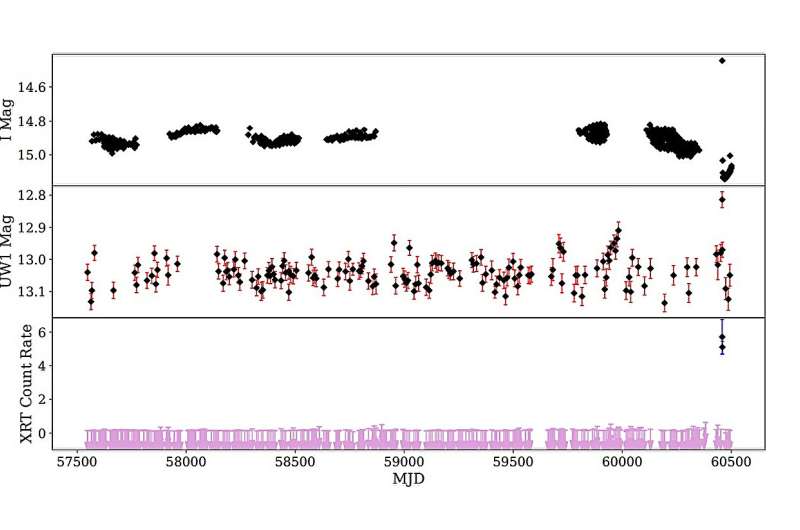August 12, 2024 report
This article has been reviewed according to Science X's editorial process and policies. Editors have highlighted the following attributes while ensuring the content's credibility:
fact-checked
preprint
trusted source
proofread
Newly discovered X-ray binary system contains a white dwarf, observations find

Astronomers from the Pennsylvania State University (PSU) and elsewhere have observed an X-ray binary system known as CXOU J005245.0-722844. They detected an X-ray outburst from this binary and found that it harbors a white dwarf star. The findings were presented in a research paper published August 2 on the pre-print server arXiv.
X-ray binaries are composed of a normal star or a white dwarf (WD) transferring mass onto a compact neutron star or a black hole. Based on the mass of the companion star, astronomers divide them into low-mass X-ray binaries (LMXBs) and high-mass X-ray binaries (HMXBs).
Be/X-ray binaries (Be/XRBs) are the largest subgroup of HMXBs. These systems consist of Be stars and, usually, neutron stars, including pulsars. Observations have found that most of these systems showcase weak persistent X-ray emission that is interrupted by outbursts lasting several weeks.
CXOU J005245.0-722844 was first identified as an X-ray source in 2009. Further observations have revealed that it is a Be/XRB in the Small Magellanic Cloud (SMC) consisting of an OBe main sequence star and a compact object.
Now, a team of astronomers led by PSU's Thomas Gaudin has employed NASA's Swift spacecraft and various ground-based telescopes to investigate CXOU J005245.0-722844.
The observational campaign detected a new very fast and highly-luminous X-ray outburst from this source in late May 2024. The X-ray spectrum for this system during the outburst was found to be supersoft in nature.
Further analysis of the X-ray spectrum of CXOU J005245.0-722844 has revealed that the system contains a white dwarf. The results suggest that this object is likely a massive carbon and oxygen (CO) WD at the upper limit of its mass range—with a mass of about 1.2 solar masses.
The study confirmed that the other object in the system is an early-type OBe star. Therefore, CXOU J005245.0-722844 is so far only the seventh candidate Be/WD X-ray binary, and the fifth such system identified in SMC.
Trying to explain the recent outburst of CXOU J005245.0-722844, the authors of the paper assume that the X-ray flash was most likely the initial thermonuclear phase of a nova outburst on the surface of the white dwarf. They added that the rapid decay time of the event indicates that very little mass was ejected during the outburst.
The observations also found that the orbital period of CXOU J005245.0-722844 has decreased from 17.55 to 17.14 days over the course of two years. However, this change is not well understood, and detailed mass transfer dynamical modeling is required in order to explain such behavior.
More information: Thomas M. Gaudin et al, CXOU J005245.0-722844: Discovery of a Be Star / White Dwarf binary system in the SMC via a very fast, super-Eddington X-ray outburst event, arXiv (2024). DOI: 10.48550/arxiv.2408.01388
Journal information: arXiv
© 2024 Science X Network



















